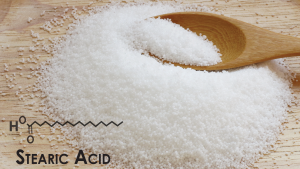Introduction
Stearic acid, a saturated fatty acid, plays a crucial role in various industries, from cosmetics to manufacturing. This article delves into the unique properties and applications of stearic acid, providing an in-depth look at its significance.
Chemical Properties and Composition
Stearic acid, with the chemical formula C18H36O2, stands out due to its long carbon chain, making it less soluble in water compared to shorter chain fatty acids. This acid exhibits a high melting point around 69.3°C, which contributes to its use in products requiring a solid form at room temperature.
Key Characteristics
- Melting Point: Approximately 69.3°C
- Solubility: Low in water
- Molecular Weight: 284.48 g/mol
Industrial Applications
Stearic acid finds extensive use across various sectors. In the cosmetic industry, it serves as a surfactant and emulsifying agent, improving product texture and stability. The manufacturing sector uses it in the production of candles, plastics, and rubber, leveraging its properties to enhance durability and flexibility.
Specific Uses
- Cosmetics: As a surfactant and emulsifier
- Candle Making: To harden wax and increase burning time
- Plastic and Rubber Manufacturing: To improve flexibility and stability
Health and Environmental Impact
Stearic acid, derived from both animal and vegetable fats, is considered safe for use in food and cosmetic products. It does not pose significant health risks when used in regulated quantities. However, sourcing from animal fats raises concerns about sustainability and ethical practices.
Environmental Considerations
- Sustainability: Depends on the source (animal or vegetable)
- Ethical Sourcing: Concerns arise from animal-derived stearic acid

Economic Aspects
The cost-effectiveness of stearic acid makes it a popular choice in various industries. Prices may vary based on the source and purity level, but it generally remains an affordable ingredient in product formulations.
Price Factors
- Source: Animal or vegetable-based
- Purity: Refined vs. unrefined grades
Conclusion
Stearic acid's unique chemical properties and versatility make it an essential ingredient in numerous applications. Its affordability and wide range of uses, from cosmetics to industrial products, highlight its importance in modern manufacturing and consumer goods.For more detailed information on stearic acid, refer to this external source.